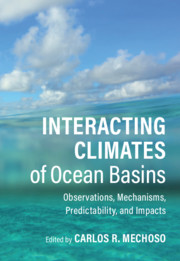Book contents
- Interacting Climates of Ocean Basins
- Interacting Climates of Ocean Basins
- Copyright page
- Contents
- Contributors
- Preface
- 1 Variability of the Oceans
- 2 Teleconnections in the Atmosphere
- 3 Atmosphere–Ocean Interactions
- 4 Interacting Interannual Variability of the Pacific and Atlantic Oceans
- 5 Indian Ocean Variability and Interactions
- 6 The Arctic Mediterranean
- 7 Combined Oceanic Influences on Continental Climates
- 8 Basin Interactions and Predictability
- 9 Climate Change and Impacts on Variability and Interactions
- Index
- References
1 - Variability of the Oceans
Published online by Cambridge University Press: 13 January 2021
- Interacting Climates of Ocean Basins
- Interacting Climates of Ocean Basins
- Copyright page
- Contents
- Contributors
- Preface
- 1 Variability of the Oceans
- 2 Teleconnections in the Atmosphere
- 3 Atmosphere–Ocean Interactions
- 4 Interacting Interannual Variability of the Pacific and Atlantic Oceans
- 5 Indian Ocean Variability and Interactions
- 6 The Arctic Mediterranean
- 7 Combined Oceanic Influences on Continental Climates
- 8 Basin Interactions and Predictability
- 9 Climate Change and Impacts on Variability and Interactions
- Index
- References
Summary
The oceans have a huge capability to store, release, and transport heat, water, and various chemical species on timescales from seasons to centuries. Their transports affect global energy, water, and biogeochemical cycles and are crucial elements of Earth’s climate system. Ocean variability, as represented, for example, by sea surface temperature (SST) variations, can result in anomalous diabatic heating or cooling of the overlying atmosphere, which can in turn alter atmospheric circulation in such a way as to feedback on ocean thermal and current structures to modify the original SST variations. Ocean–atmosphere interactions in one ocean basin can also influence remote regions via interbasin teleconnections that can trigger responses having both local and far-field impacts. This chapter highlights the defining aspects of the climate in individual ocean basins, including mean states, seasonal cycles, interannual-to-interdecadal variability, and interactions with other basins. Key components of the global and tropical ocean observing system are also described.
- Type
- Chapter
- Information
- Interacting Climates of Ocean BasinsObservations, Mechanisms, Predictability, and Impacts, pp. 1 - 53Publisher: Cambridge University PressPrint publication year: 2020
References
- 2
- Cited by



